

A Few Threads Loose: How to Properly Mend Sewing Patterns. Pattern repair and preservation are topics that don't come up very often unless you're a die-hard pattern collector, or an experienced sewing pattern seller.
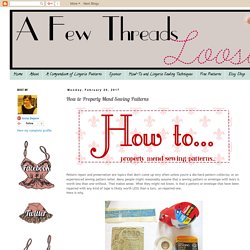
Many people might reasonably assume that a sewing pattern or envelope with tears is worth less than one without. That makes sense. What they might not know, is that a pattern or envelope that have been repaired with any kind of tape is likely worth LESS than a torn, un-repaired one. Here is why. Tape adhesive can degrade and change color over the years. Where To Buy Vintage Patterns & How To Sew Them. I recently wrote an extensive guide on where to buy new dressmaking patterns, but ‘new’ may not be your style!
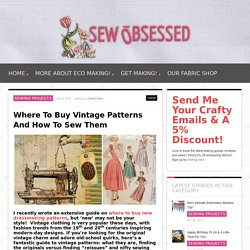
Vintage clothing is very popular these days, with fashion trends from the 19th and 20th centuries inspiring modern-day designs. If you’re looking for the original vintage charm and adore old-school quirks, here’s a fantastic guide to vintage patterns: what they are, finding the originals versus finding “reissues” and nifty sewing tips. Pattern Patter : Vintage Resources and Tutorials. The Merits of a Basic Fitting Pattern. Slopers help simplify the fitting process. by Karen Howlandfrom Threads #79, pp. 48-52 When I started out as a custom dressmaker, I needed a way to simplify the fitting process.

So I turned to patternmaking, where I learned how to draft basic fitting patterns, called slopers, and create different styles of garments from them. I was excited about using slopers to make my own patterns, as designers do. Sewing Patterns,Vintage,Out of Print,Retro,Vogue Simplicity McCall's,Over 7000 - Home. Vintage Sewing Techniques & Tutorials.
I hope these varied Tutorials, Hints, Tips & Articles have been in some way helpful, as I have a number of these planned any feedback is gratefully received!
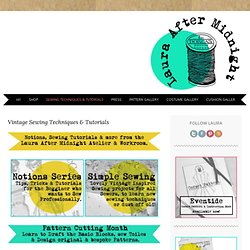
American Duchess: How To: Sizing Up Vintage Patterns For Modern Wear. Never fear, dear readers, for while this particular tutorial is showing a vintage 1950s pattern, these techniques can be used for any pattern that is not your size.
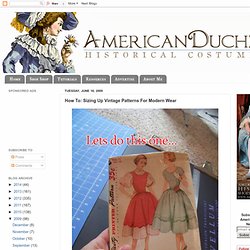
Generally we find that patterns from the past are smaller than our modern bodies. When this is the case, it's time to employ one method or another for enlarging the pattern and getting it to fit. This is the first in a series of pattern alteration tutorials. These tutorials will cover various ways to enlarge patterns from vintage tissue (your grandmother's Simplicity patterns) to gridded books (Janet Arnold and other notorious sources). This method is best used for patterns that are no more than 5"-6" smaller than your measurements. If you're into costuming, chances are you've acquired along the way some delightful vintage patterns from the 1930s, 40s, and 50s. For this tutorial I chose a fairly simple-looking pattern, a lovely 50s summer dress. Step1: Trace the Bodice Front piece, all lines and markings.
Congrats! The Midvale Cottage Post: History of Sewing - De-Mystifying Unprinted Patterns. Sewing with unprinted patterns sounds intimidating to many sewists, especially those new to vintage sewing.
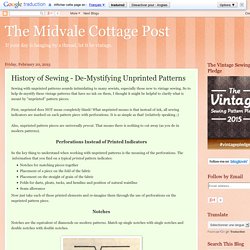
So to help de-mystify these vintage patterns that have no ink on them, I thought it might be helpful to clarify what is meant by "unprinted" pattern pieces. First, unprinted does NOT mean completely blank! What unprinted means is that instead of ink, all sewing indicators are marked on each pattern piece with perforations. It is as simple as that!
(relatively speaking ;) Also, unprinted pattern pieces are universally precut. Perforations Instead of Printed Indicators So the key thing to understand when working with unprinted patterns is the meaning of the perforations. Now just take each of those printed elements and re-imagine them through the use of perforations on the unprinted pattern piece. Notches Notches are the equivalent of diamonds on modern patterns. The vintage pattern primer. This post has been prompted by the many emails I’ve received on the topic of sewing with vintage patterns.

Where do I start? How do I use a vintage pattern? What about sizing? Any tips? I really appreciate that people ask me–vintage sewing patterns are something I love working with and enjoy sharing that magic with others. Vintage patterns can come off as intimidating to not only those new to sewing, but seasoned dressmakers as well. A warning: this post started innocently with a handful of tips and quickly ballooned into a novel. Trace all your pattern pieces. Have a good sewing reference book handy. Pay attention to the pattern markings. FIT! If a pattern is something that is comprised of many pieces, cut on the bias, looks tricky, or just gives me the heebie jeebies about fit, I make a mock up or “muslin” of at least the bodice first (I can usually fudge my way through the skirt in a dress).
Vintage Pattern Grading. Vintage Pattern Fit and Sizing. The most wonderful sewing projects can start with a vintage sewing pattern.
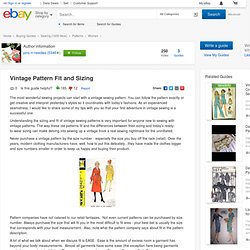
You can follow the pattern exactly or get creative and interpret yesterday's styles so it coordinates with today's fashions. As an experienced seamstress, I would like to share some of my tips with you so that your first adventure in vintage sewing is a successful one. Understanding the sizing and fit of vintage sewing patterns is very important for anyone new to sewing with vintage patterns. The way these old patterns fit and the differences between their sizing and today's ready-to-wear sizing can make delving into sewing up a vintage frock a real sewing nightmare for the uninitiated.
Never purchase a vintage pattern by the size number - especially the size you buy off the rack (retail). Pattern companies have not catered to our retail fantasies. A lot of what we talk about when we discuss fit is EASE. The biggest part of that difference is that we want to be comfortable in our clothes. Working with Vintage Patterns. Jack Deutsch Scott Phillips Photo: Jack Deutsch by Alexandra Reynoldsfrom Threads #132, pp. 47-51 Ever since I was a preteen, I've been captivated by vintage style.
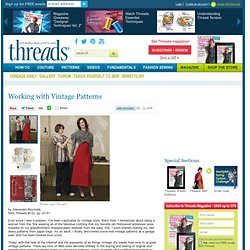
Back then, I fantasized about being a woman from the '30s wearing all of the fabulous clothing that my favorite old Hollywood actresses wore. Inspired by my grandmother's dropped-waist dresses from the early '20s, I soon started making my own dress patterns from paper bags. Today, with the help of the Internet and the popularity of all things vintage, it's easier than ever to acquire vintage patterns. Sewing with the real-deal pattern in its original form is a wonderful experience and a fun way to re-create the innovative details and flattering designs of the past. Here, I'll explain the major differences and show you techniques that will help you easily navigate the world of vintage patterns. Early 1900s—French couture designers and theater actresses influenced the pattern designs of the time.